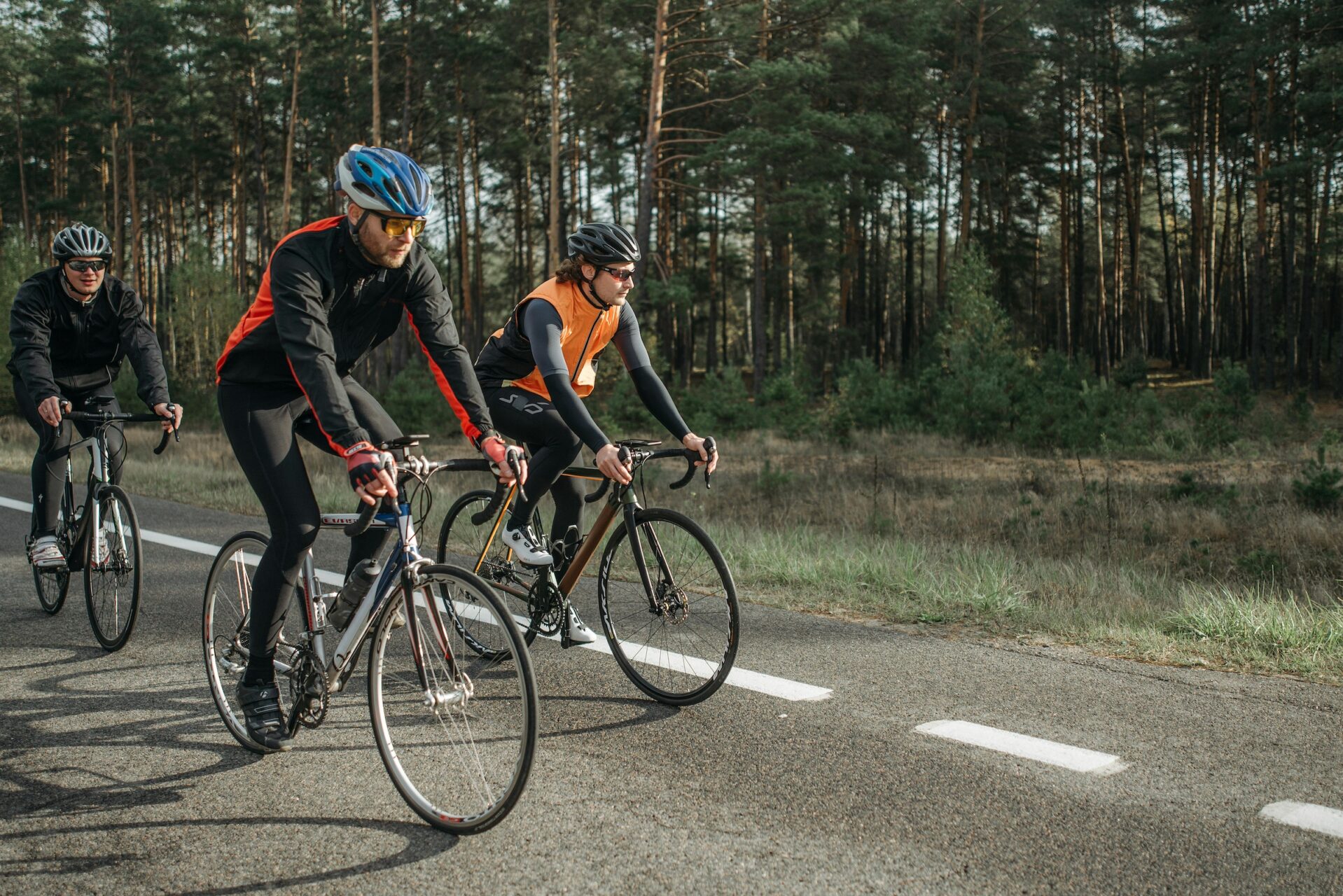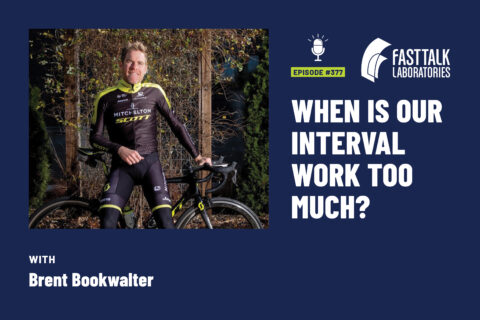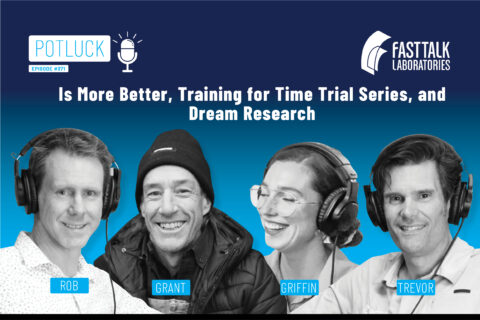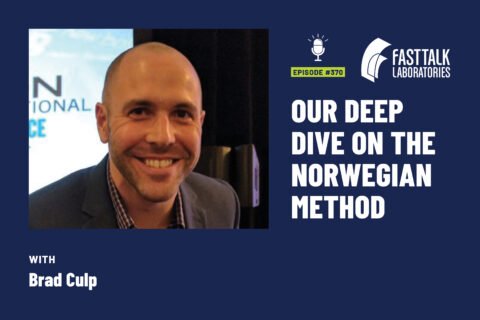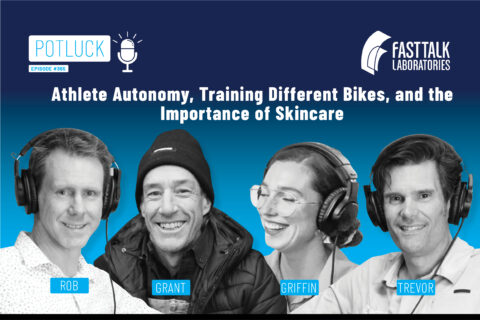Precisely how should you structure a week, a month, or a year of training to fit in between all the time-snagging realities of life? Listen to find out.
Episode Transcript
Intro 00:00
Welcome to Fast Talk, a VeloNews podcast and everything you need to run like a pro.
Trevor Connor 00:14
What a lot of people do – they just say “Okay, I’ve only got six hours. So I’m gonna go do six high intensity workouts.” And we’ve already addressed that that’s not –
Dr. John Hawley 00:23
Any extreme is dangerous. And if you do that, doesn’t matter whether it’s training, nutrition, religion, or whatever you need, you need the balance. You need a periodized training program and you need periodized nutrition to support that.
Trevor Connor 00:36
Welcome back to Fast Talk, the VeloNews performance podcast. I’m your co-host coach Trevor Connor, here with VeloNews Senior Editor Caley Fretz. Today we’ll delve into part two of our series on how to structure your training. As we were just reminded by Dr. John Hawley, one of the preeminent researchers in exercise science, it’s always about balance. In part one of this series, we covered the principles of a balanced training program. Why you see the best results from a mix of intensity and slow training. And why there’s such a thing as too much intensity from a physiological standpoint. We also touched on periodization, which is all about manipulating that balance of volume and intensity throughout your season in order to get your peak performance at the right times. In this part two episode, we’ll take those principles from part one and talk about the execution. We’ll explore ways to map out your week, your month, and touch on how to best execute both your intensity work and your long, slow volume. And of course, for all of us who have jobs and families, we’ll talk about how to do this if you only have six to 10 hours to train each week. Dr. Hawley, who’s also the head of the exercise and nutrition research group at Australian Catholic University will help us along the way. And we’ll also hear from former US National masters champion Chris Phipps. Let’s make it fast. Caley, you tell me. Now that you don’t have the the time to train that you used to have, what have you found that works?
Caley Fretz 02:03
I think works is relative. I haven’t seen the power numbers of my racing days in a long time. But that said, I am relatively close and have managed to ride relatively well despite the work. I would say the highlight would be I raced Leadville a couple years ago, after covering the Tour de France. Had a bike with me and was riding an hour, hour and a half at a time. And managed a pretty good ride at Leadville anyway. And for me the key has always been, get out for a big day when I can. I call it shock and awe training. I try to shock my body into remembering what it feels like to ride for five hours. And I may only get to do that once a month or so. The rest of the time, I don’t do a lot of focus training anymore. But if I was focusing on a race, I probably would. I would say my average week is a couple lunch rides. I hit the the Thursday throwdown with the panache guys here in Boulder, and then try to get a big round in the weekend – am I on the right track?
Trevor Connor 03:01
What you brought up there, to me is a really important part of the question of “What are you trying to do with your fitness?” There is a ton you can do with six to eight hours a week. Especially if you say, “I just want to do well at the local lunch ride,” or “I want to race crits.” If you’re building up to do a five day large stage race and you’re training six hours a week, you might want to rethink that. You’re not really going to be able to build that form. But there is a lot that you can do. So what does all this mean? What should you be doing?
The Average Training Week
Caley Fretz 03:33
Yeah, break this down for me. So give me an average week. I think that would be most helpful.
Trevor Connor 03:37
So I would start with mapping out your high intensity work. Plan on two high intensity sessions during the week, and they should not be back to back. So maybe you do one on Tuesday and one on Friday. Or one on Tuesday one on Thursday. It’s usually pretty popular to do the high intensity work during the week because that’s when you work. And you might be stuck on a train for an hour. Or you might be stuck doing a lunchtime ride. So high intensity work is a great thing to do. And I’ve only got an hour to get on the bike. Let’s go out and do it.
Caley Fretz 04:09
And a hard group ride or interval session or whatever, any of those work?
Trevor Connor 04:14
I think hard group rides are great, but go out to ride them hard. I always tell my athletes race smart on the weekends race hard during the week. So as you go to a group ride, don’t sit and save your energy till the end. Attack. Go on breakaways, blow yourself up, because that’s more like the interval work. And let the group motivate you. For those of us who work, that’s a really great balance. Get the two interval sessions in a week. Don’t do more than that. I watched this winter these trainer sessions I was doing in the morning. I watched some of the athletes and I really admired their dedication. But they were coming in four days a week doing intervals every single morning. And again, what you were seeing is they were very rapidly burning out. By the time they got to my session, which was Thursday, they couldn’t even finish it. And they weren’t getting stronger. So to his right, you’re actually going to see greater gains with less. And then if you have the time, you still get that benefit from the long, slow volume. A lot of us on the weekends, we can get up a little early and go out and get that 345 hour ride. And you get those three things, it’s going to work out to about seven, eight hours a week, which is pretty manageable, you’re going to you’re going to hit that PGC alpha pathway from both the long slow volume side, and from the high intensity side. And you’re going to maximize the time.
Caley Fretz 05:39
We caught up with Chris Phipps, who’s a former Masters national champion, and as a Masters national champion did so with a job. And so we asked him about how he maintained his training schedule with limited time.
Chris Phipps 05:52
My volume isn’t as much as a lot of guys, which is easy to compare on something like Strava. You look at all your competitions. This guy’s training 20 hours a week, and this guy is doing 15 hours a week. But I generally tried to hit 12 times during the season and I average, like 10 hours a week during the whole year. So usually after work, it’s just either an hour or 90 minutes most days and then get in a couple long rides in the weekend. And anything at one 4 hour plus ride in and, say, two of those every three weeks. That’s pretty good. And also at the longest daylight we can do that ride and then add on. The one week night, I’m out kind of long. Two to three hours in intensity and a little more endurance. And then it’s more daylight. I like two longer nights during the week. During base season I’m pretty short, every night during the week. But during the season, I try to get at least two hours twice a week. And then do the longer stuff on the weekends.
Polarized Training Model
Caley Fretz 06:51
So Trevor, we talked earlier about the polarized model and how it’s being used by a lot of pros. But does it really work for your average cyclist or average amateur cyclist? Is it a model that we can apply to our own lives and training?
Trevor Connor 07:04
Yeah, that’s a good question. And certainly, they’ve been showing in all endurance sports, your top definitely polarize their training. And they’ve even been showing that at amateurs they seem to see greater gains with a more polarized model. That being said, when they looked at the individual sport, cycling was a little bit different. Cyclists actually do a little more of that in between training, which we would call threshold training. So where runners and rowers would just do very high intensity or very long-slow, cyclists are actually going to do more of a mix of about 77%, low intensity 15% threshold work. And only about 8% high intensity. Once they get into the season, the high intensity increases. The threshold comes down. In terms of what all this means, what the right balance is, Dr. Billett did a great study – and I’m sure I’m mispronouncing his name – with runners where they looked at what’s the best mix of the different types of training. What they found worked best was four slow workouts during the week, one high intensity. So that’s above threshold, short interval work. And one threshold workout per week produced the best gains. But they actually increased that to where they were doing two continuous training – what they’re calling continuous trainer. That slow running during the week, multiple high intensity sessions per week and one threshold workout. There’s absolutely no greater gains. But all the signs of burnout started to appear. And frankly, these athletes just wouldn’t have been able to keep it up for more than a few weeks. So it’s really keeping that high end work to two sessions per week, is what keeps coming up.
Trevor Connor 08:49
Dr. Hawley had some thoughts to share with us in both polarized training and how much intensity work we really need.
Dr. John Hawley 08:55
Steve’s done some great work on the polarized training. If you look at the rowers, and the cyclists, and probably even the runners, there’s a huge volume of – let’s just call it steady state aerobic work. And it’s peppered in between with very bits of high intensity or even super maximal intensity. And again, that seems to be what works for the athletes. I’m not sure you need to do intervals all year round. I’m not sure really how long you need to do intervals if you want to get really, really sharp. My guess is you can probably do this in three to six weeks if you look at a periodized training program. But again, most athletes don’t aim for one event like the Olympics. They’ve got races throughout the year. So it’s quite different depending on the caliber of athlete.
Trevor Connor 09:38
So if you want an example of how important this balance is, and just how much you want to avoid doing too much high intensity work, you can look at the gold medalist in the 4000 meter pursuit at the 2000 Sydney Olympics. They actually did a study on them and it was amazing how they built up to that race. The riders on this German team. And it wasn’t what you would think. They actually did very, very high volume in the seven months building up, a lot of them were pros. And were actually doing grand tours as a build up to these Olympics. And it was only in the final eight days before the Olympics that they started doing very specific on the track high intensity work to get ready for the Olympics. And they won the gold medal.
High Intensity Work
Caley Fretz 10:24
So what exactly do you mean by high intensity work? I mean, that could be a lot of different things.
Trevor Connor 10:29
Yeah, and there’s a lot of different ways to do it. But typically what we’re thinking about with high intensity work, and where you see some of the biggest gains is these very short intervals. 15 second intervals, 22nd intervals, or one minute, 40 seconds. But typically a short interval with also a short recovery. You think of the Tabata style intervals. Which is 20 seconds going all out, then a 10 second recovery, then another 20 seconds going all out, and you keep repeating that for four or five minutes. So that’s till you puke. You could also do sprint type work. That sort of interval work is where you see some of the biggest gains. But there’s actually another type of interval work that a lot of coaches and physiologists I’ve spoken to talk about threshold work where you train just sub threshold. Some coaches feel that’s kind of the poor man’s volume, right? If you can’t go out and get a five hour ride, go out and do some 20 minute intervals, at just sub threshold. Like 95% threshold. That that can compensate a little bit for volume. Not sure where I stand on that. But I will admit to you, with a lot of athletes who don’t have a ton of time, when we’re really focused on building that endurance, and I feel the the volume is a little more important. I will mix in threshold work.
Caley Fretz 11:50
So we know what those intensity rides look like. They’re a hard group ride or interval session or whatever, what exactly does the big long weekend ride look like? So let’s just for the sake of argument, my threshold’s 300 watts. What am I watching on my power meter for three and a half, four hours?
Trevor Connor 12:06
So that also depends on where you’re at in the season. So when you’re in the base, that ride should be going talking pace.
Caley Fretz 12:14
Gotcha.
Trevor Connor 12:14
And again, that’s actually one where I’ve really struggled with. Some of the riders I’m working with, they have full time jobs, and they have six to eight hours. I’ll go out and ride with them on a Saturday. And I’m the one sitting there yelling “Slowdown, you’re killing me!” You go out in January, and they’re trying to put out 240 watts for four hours. When I say it’s slow, it is slow. So for example, if your threshold was 300 watts, you should be going out in January and February at 150-160 watts. So we’re talking, same thing, heart rate. If your threshold heart rate was 170, or let’s say your max heart rates in the 180-190s, we’re talking riding at about a 130 heart rate. But as you get closer to the season, especially as you get into the season, you start racing. That’s where you can start up in the intensity a little bit. And especially as you start getting close to the race season. Go out and do the group rides. Go out and get for your long ride a little more intensity, where you’re more in that sweet spot zone. That gives you that race specificity. So you aren’t suddenly going from riding four hours at 160 watts to trying to hang on at 240-250 watts. So that really depends on the time of the year.
Trevor Connor 13:33
We asked Dr. Hawley about the benefits of long rides, how frequently we really need them. And if it’s possible to compensate for long rides, if you simply don’t have the time.
Long Ride Training
Dr. John Hawley 13:42
No, no, this certainly, in any fabric, I guess in any sort of 7 to 10 day period, I always put on longest ride or longest running. And if you go out, the longer you go, the more you tend towards free fatty acid oxidation. But again, you’ve got to remember that unless you’re doing a five hour ride race at that pace, it doesn’t necessarily help racing. All it does is build up amensa capillaries. Again, it gets the muscle used to using fat and turning on beta oxidation and all these adaptations at the muscle, which you know about. So, yes, there is a point to that. But again, when I send you the articles, you’ll see that if it’s a race situation, at the end of the day, even if it’s a three hour race, it’s carbohydrate dependent and not fat dependent. Having the ability to utilize fat at the highest rates possible, it is an advantage in long endurance events. But again, the goals of the person and the race in mind. So the answer to your question is, I would think every seven to 10 days there should be one very long ride in there. Absolutely. And again, depending on the ability level of a person, that might be two hours. It might be five or six for someone who’s been in the sport a lot longer. The great New Zealand coach Arthur Lydiard coached probably half a dozen Olympic gold medalists. He even have runners like Peter Snell who won the 800 and 1500 doing very long Sunday morning runs, sometimes up to 20 miles. And Snell, if you talk to him now, I know Peter reasonably well, he’d say, “Look, I’m not quite sure what I was doing at the time.” But now, you know, he’s an exercise physiologist at Southwest in Texas. And he said, “Look, you know, now I know the physiology behind this.” The other thing that the rides do is go through the whole fiber population. If you just go out and ride for an hour, you’ll tap into some slow twitch fibers. And you do this and you do that. But by going along, and almost going to exhaustion at that submaximal pace, you’re then asking the muscles to recruit the slow twitch fibers, the fast twitch A the fast twitch B. And unless you do very high intensity intervals, I don’t think you do that. So you’ve got two ways of tapping into that fiber population. Either go long and slow to exhaustion, or basically do high intensity and wipe them all out anyway. So I think another advantage of the long ride is to get all the fibers active. And at the end of those rides, you’re calling on fibers like the two A’s and two B’s which aren’t that used or aren’t that good at doing that endurance. And I think that’s an important thing as well. To make sure that all the fiber population has been recruited and has that potential to use as much fat as it actually can. The 2B fiber isn’t very good at that. But use everything you’ve got type thing. And that’s another reason for doing a long ride. We often do rides to exhaustion in the lab. And they’re fine for the first hour. You get to the second hour it gets a bit tougher and you get to the third hour, the workload hasn’t changed. But of course, the fiber recruitment hasn’t. 2B fibers don’t like working at 250 watts, they prefer working at 550 for 30 seconds. So it’s a really hard ask of the muscle. But only by using the muscle and driving it to that point, do you actually recruit it. So I think it’s a vital reason and yeah, you’ve already hit on it. But most people forget that. And I think that’s a very important reason. In fact, I put that right up there as with fat burn in the recruitment pattern. It’s vital.
Trevor Connor 17:00
Do you think they can produce a lot of the gains? If they simply don’t have the time for a longer ride? Or is there just no way to substitute for the long ride?
Dr. John Hawley 17:08
I think that’s a great question. Because again, most people are asking for the minimum they can do rather than the maximum they can do. And look, you may not on an hour and a half training hit 100% of your genetic potential. But you’ll be 94-95% close. So I’m a case in point. I was competitive, I don’t have four or five hours to train. Now, I have an hour or an hour and a half at the most. I have to make it work. A typical session is 40 minute warmup on the bike. And then 10 times one minute as flat out as I can with a minute recovery. And I know when I go overseas, for another 10 days, I come back and provide documentation intensity while I’m overseas, I come back and I’m pleasantly surprised. So again, I think you can get good bang for the buck.
Trevor Connor 17:55
Another big mistake that I often see athletes make is to do the same thing every single week. Our bodies are really good at adapting to whatever we throw at them. And once our bodies get used to something, they go, “Well, why am I gonna adapt anymore? I can handle this.” So you’ll see initial gains. But if you’re doing the same two interval sessions and long ride every week, you’re going to plateau very rapidly. So you need to have weeks where you really beat yourself up. And this is where you can see some of your biggest gains. And I find it really works well with the athletes that I have that have a family and have full time jobs. So most of the weeks, we just say let’s get done what you can get done. If you can only train five, six hours per week, that’s fine. But what I asked for is about once a month, every four or five weeks, I want you to find three, four days in a row where you tell the family “Sorry, you’re not going to see much of me.” You find the time with work and you go out. And you do some good volume and some good intensity. A good format that I’ll give somebody is Thursday, we’ll do intervals. Because you still have to go to work. And for pretty strong athletes, I might do intervals again on Friday. Then Saturday, do a long, easy ride of four hours. And then Sunday, go and hit the group ride, explode, keep riding get five hours in. By the end of that week, and there’s a lot of different ways to balance it. But by the end of that, that Sunday, you want to be limping home and saying I’m pretty tired. And then the following week, you start by taking two, three days off. Another couple days of riding easy, you let all that work you did sink in. And you’re gonna come out of it at a higher level. And then you could have a few more weeks of just normal training.
Caley Fretz 19:42
So it’s a mini training camp, basically. Right. So I think it’s pretty clear that I’ve been doing it all wrong. I think that’s the most clear thing from the last 20 minutes of conversation. But relatively easy changes to make, and I will certainly be adjusting my my weekly training to fit what we’re talking about today. And I think we can sum up the takeaways pretty quickly, right? I mean, balance is the key, both on a micro scale and a macro scale. So both within within a week, and within a month and within your whole season. Run me through what that week and month should really look like, you know, one or two sentences.
Trevor Connor 20:21
So if I had to summarize all this, it’s yes, intensity can compensate for volume to a degree. But when it comes to intensity, more is not better. Two intensity sessions per week is ideal. Getting one long ride in per week really adds to those gains. And it’s trying to balance everything. It’s trying to balance it all together. And then in terms of your month, making sure you don’t do the same thing week in week out. Have that periodic week, where you beat yourself up a little more. And then just as importantly, have the week after where you recover. The even more important question to agree is, what are you looking to do? Are you looking to really get stronger or are you just looking to have some fun? Because you’re just trying to have some fun, go and hit all the lunchtime rides, go and hit the weekend ride. It might not necessarily always be the best training, but if you’re enjoying it, what are you out there for?
Caley Fretz 21:18
Well, that’s Fast Talk. We’re gonna wrap up for the day. Thanks for tuning in, and we’ll see you next time.
